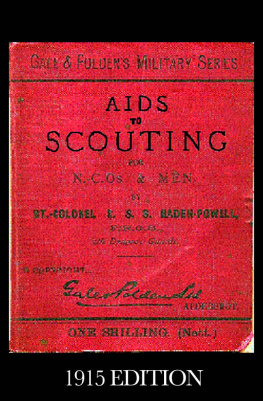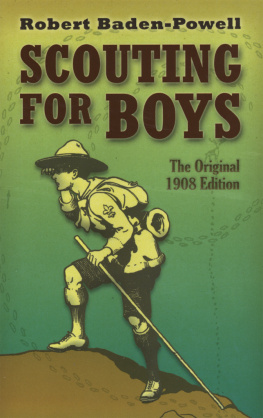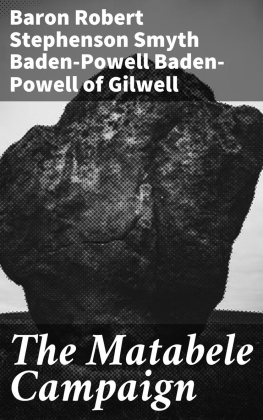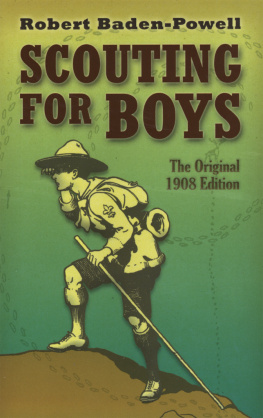SIR ROBERT BADEN-POWELL
Foreword by
Peter Earnest
Executive Director
International Spy Museum
Introduction by
Matthew Arnold
Book Specialist
International Spy Museum
DOVER PUBLICATIONS, INC.
Mineola, New York
Copyright
Copyright 2011 by Dover Publications, Inc.
All rights reserved.
Bibliographical Note
This Dover edition, first published in 2011, is an unabridged republication of the work originally published in 1915 by C. Arthur Pearson, Ltd., London. A new frontispiece has been added to this edition, and the Table of Contents has been revised. Peter Earnest has provided a new Foreword and Matthew Arnold a new Introduction.
Library of Congress Cataloging-in-Publication Data
Baden-Powell of Gilwell, Robert Stephenson Smyth Baden-Powell, Baron, 18571941.
My adventures as a spy / Robert Baden-Powell; foreword by Peter Earnest; introduction by Matthew Arnold.
p. cm.
Originally published: London : C. Arthur Pearson, 1915.
Summary: An older book for a younger audience, this charming volume was written by a British military hero during the first years of World War I. Baden-Powell, who founded the Boy Scouts, relates such espionage basics as disguise, hiding messages in innocuous objects, creating diversions, escaping capture, and other maneuversProvided by publisher.
ISBN-13: 978-0-486-48208-8 (pbk.)
ISBN-10: 0-486-48208-1 (pbk.)
1. Baden-Powell of Gilwell, Robert Stephenson Smyth Baden-Powell, Baron, 18571941. 2. SpiesGreat BritainBiography. I. Title.
UB270.B15 2011
940.48641092dc22
2011008701
International Standard Book Number
eISBN-13: 978-0-486-32045-8
Manufactured in the United States by Courier Corporation
48208101
www.doverpublications.com
Contents
Foreword to the Dover Edition
F LYING over the rugged mountain range under a clear blue sky, the propeller-driven, General Atomics MQ-1 Predator, an Unmanned Aerial Vehicle (UAV), readily identifies the heat signature of a human body some 10,000 ft. below. The pilot and his three man crew sit huddled in a small room, the Ground Control Station (GCS), surrounded by computer monitors, working out of a non-descript building thousands of miles away on a U.S. Air Force Base in Nevada. They decide to loiter over the area to spot any suspicious activity. And though its on a routine surveillance mission cruising at over 100 miles an hour, the drone carries two AGM-114 Hellfire missiles armed and ready to launch.
This sleek aircraft would have been beyond Sir Robert Baden-Powells wildest dreams. Yet he would have quickly grasped how this 21st Century, high tech, winged specter was scouting out enemy territory and recording it as he had done a hundred years ago, albeit this time with a powerful, digitally-enhanced, infrared zoom camera and not pen and ink sketches to record the findings.
A national military hero, Baden-Powell was a popular public advocate of ground reconnaissance, scouting out an adversarys terrain and learning his defenses. Following ancient Chinese strategist Sun Tzus first principle, know your enemy, he worked at perfecting the craft of reconnaissance and, more importantly, to convince his superiors and later the public of its value. He was dead right in his instincts, even though his own scouting exploits seem rather quaint in hindsight.
In Baden-Powells view, using disguise in his reconnaissance missions was essential to sound military operations. In fact, disguise was successfully employed by the CIA and other intelligence services throughout the Cold War and up to the present day, the first decade of the 21st century, in which Intelligence is viewed as the first line of defense against terrorism.
Disguise frequently appears in books, Hollywood films, and TV programs about espionage; its part of every youngsters first impression of what spies do. As Executive Director of the International Spy Museum in Washington, D.C., I often have the opportunity to speak with our young visitors and their parents and teachers. I get a big kick out of seeing many of them arrive at the Museum disguised in fake moustaches and wearing black fedoras including the girls!
In fact, during my 36 years in the Central Intelligence Agency and its Clandestine Service, I engaged in operations in which I used an alias or cover name to conceal my true identity and, on occasion, a disguise to hide even my appearance. To perfect our use of disguise in operations, we consulted with Hollywoods top disguise artist, John Chambers, the man who had designed the masterful disguises for the highly popular, Planet of the Apes. The Agency awarded him a special medal of recognition for his contributions.
Baden-Powell enjoyed great success and widespread public recognition for his books and lectures preaching his passion for intelligence gathering to a post-World War I public increasingly fascinated by espionage as it was portrayed in popular culture. So for his efforts to help the public and his own military colleagues develop a better understanding of the fundamentals of Intelligence, he deserves special mention in the annals of Intelligence history.
PETER EARNEST
Executive Director
International Spy Museum
Introduction to the Dover Edition
T HE life and career of Lord Robert Stephenson Smyth Baden-Powell was one of great achievement and honors. He was first propelled to national celebrity in England as a decorated war hero. Today, he is best-known as the founder of the Scout Movement. His publication of Scouting for Boys in 1908 ignited the international interest in promoting the development of young people for society through an emphasis on outdoor activities. Numbering over 28 million members in 216 countries worldwide, the Scout Movement is the worlds most successful youth organization and the book, now known as The Boy Scout Handbook, is estimated to be the fourth best-selling book of the twentieth century.
A prolific author with over thirty books to his credit, Baden-Powell could also count among his talents ambidextrous artist, actor, sportsman, and spymaster. With the publication of My Adventures as a Spy in 1915, he would add teacher of spycraft to that of teacher of scoutcraft. At the outbreak of the First World War, he called upon his considerable expertise and accomplishments in espionage and counterintelligence to argue passionately that the country should develop spies for the war effort. To illustrate his case, the book set out to distinguish different types of spies through his and others spy stories. Unfortunately, Baden-Powells capabilities as a story-teller, his desire to contribute to the war effort, and perhaps a little self-promotion would take precedence over the historical accuracy of his events. Future historians would be left to decipher the facts from the fiction in his book, but there is little doubt that he had a fertile mind and passion for the subject of intelligence gathering.










